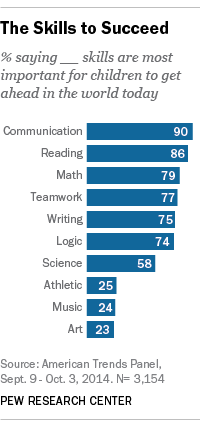This post comes from this link. I didn’t have anything to add; I just wanted to point it out.
Pew Research Center recently asked a national sample of adults to select among a list of 10 skills: “Regardless of whether or not you think these skills are good to have, which ones do you think are most important for children to get ahead in the world today?”
The answer was clear. Across the board, more respondents said communication skills were most important, followed by reading, math, teamwork, writing and logic. Science fell somewhere in the middle, with more than half of Americans saying it was important.
Rounding out the bottom were skills more associated with kids’ extracurricular activities: art, music (sorry, right-brained people) and athletics. There was virtually no difference in the responses based on whether the person was a parent of a child aged 18 and younger or not.
